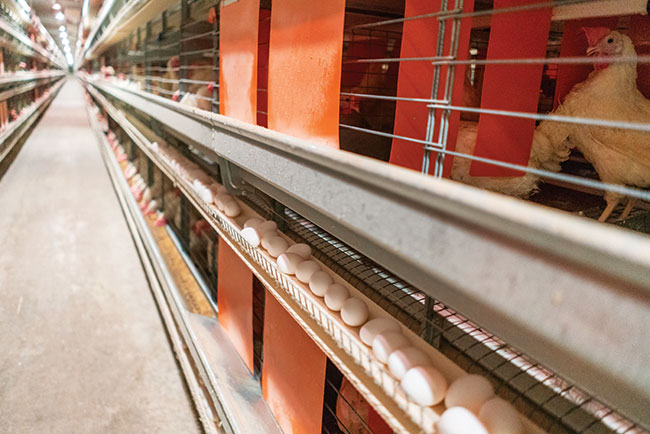
LRIC Update: Hen housing and egg quality
By Lilian Schaer
Features HousingAlternative housing systems can change eggshell cuticle quality, new research shows.
 New research from the University of Ottawa shows that alternative housing systems can change eggshell cuticle quality.
PHOTO CREDIT: Big Dutchman
New research from the University of Ottawa shows that alternative housing systems can change eggshell cuticle quality.
PHOTO CREDIT: Big Dutchman New research from the University of Ottawa shows that alternative laying hen housing systems can change eggshell cuticle quality, which reduces the risk of bacterial contamination and boosts food safety. The cuticle is the outer layer of the eggshell and serves as both a physical and chemical barrier against bacteria.
Egg farmers are increasingly moving away from conventional hen housing with cages to alternative-style barns that meet growing consumer demands for more welfare-friendly production. Enriched cage, free-run and free-range systems offer birds more freedom to express their natural behaviours. This potentially reduces their stress, which, in turn, can alter the physiology of the egg as well as impact the quality and deposition of the cuticle.
For the egg industry, a safe, nutritious and pathogen-free table egg is an absolute necessity. The number of bacteria on the eggshell surface is a key predictor of how many bacteria might penetrate the egg. The eggshell’s outer cuticle layer is the first line of defense to keep out bacteria like Salmonella, which can cause food borne illness in humans, from entering and contaminating the egg.
“The egg is designed as a package to deliver life to the next generation. So, there are respiratory pores in the shell that deliver gases to the embryo inside – and this is also how bacteria can get in,” explains Dr. Maxwell Hincke of the University of Ottawa, who has recently completed research into this issue in partnership with Burnbrae Farms.
Post-doctoral researcher Dr. Garima Kulshreshtha led the work to examine and establish differences in shell cuticle properties of eggs stemming from birds living in different housing systems. She used spectroscopy and electron microscopy to evaluate the cuticle components and its characteristics. Kulshreshtha also developed an assay to identify how antimicrobial or hydrophobic proteins resist Salmonella adherence to the eggshell surface.
Study results showed that the cuticle plug thickness and pore length were higher in the free-range eggs as compared to conventional eggs, and eggshells from alternative caging (enriched and free-range) had a higher total cuticle compared to eggs from conventional cages.
“We observed that there are differences among eggs from different housing systems, with eggs from alternative housing having better cuticle quality than those from conventional systems,” Kulshreshtha says. “We also observed that bacteria adhered less easily to eggs from free-range housing compared to enriched housing. These results indicate that the housing systems of layer hens can modify the cuticle quality and thereby impact bacterial adherence and food safety.”
As the industry adapts its production practices to respond to demands from consumers, research like this is important, Hincke believes, to ensure quality and safety aren’t negatively impacted by the changes.
At the same time, the industry’s investment in this type of research can help assure consumers that egg producers are committed to delivering safe, nutritious eggs in a sustainable manner.
“Our study is the first to show that housing systems can impact cuticle and food safety parameters and that there is variability – nobody has ever done this before and it’s important to know this type of information as we transition to alternative housing systems,” Kulshreshtha adds.
This project was funded by Egg Farmers of Ontario (EFO) with in-kind support from Burnbrae Farms. Egg Farmers of Canada, the Natural Sciences and Engineering Research Council and U.S. Poultry have contributed to Hincke’s previous research into eggshell quality, washing and cuticle evaluation that served as background to this study.
Livestock Research Innovation Corporation works with EFO to manage all aspects of its research funding program.
This article is provided by Livestock Research Innovation Corporation as part of LRIC’s ongoing efforts to drive innovation in livestock production.
Livestock Research Innovation Corporation (LRIC) fosters research collaboration and drives innovation in the livestock and poultry industry. Visit www.livestockresearch.ca or follow @LivestockInnov on Twitter.
Print this page